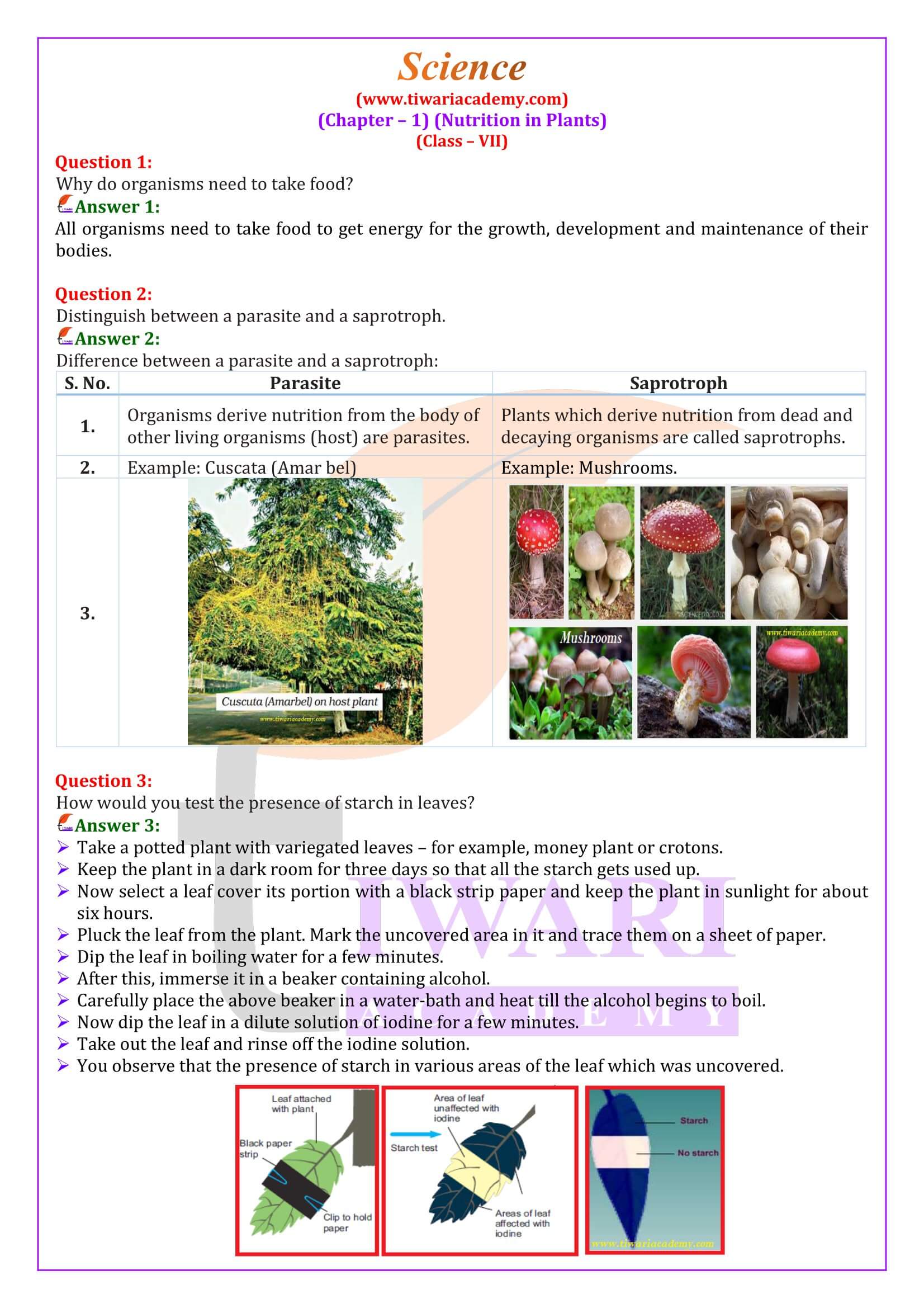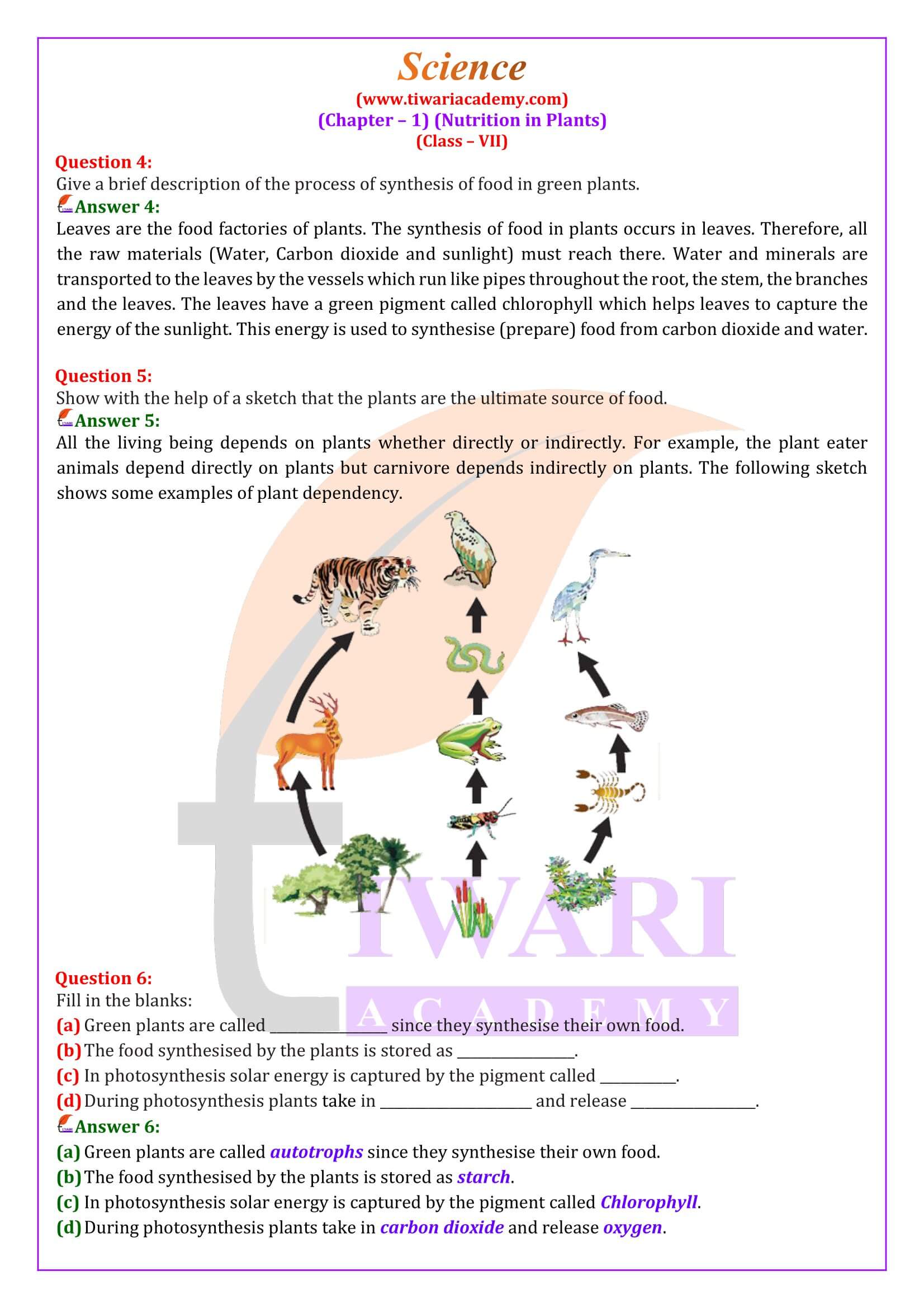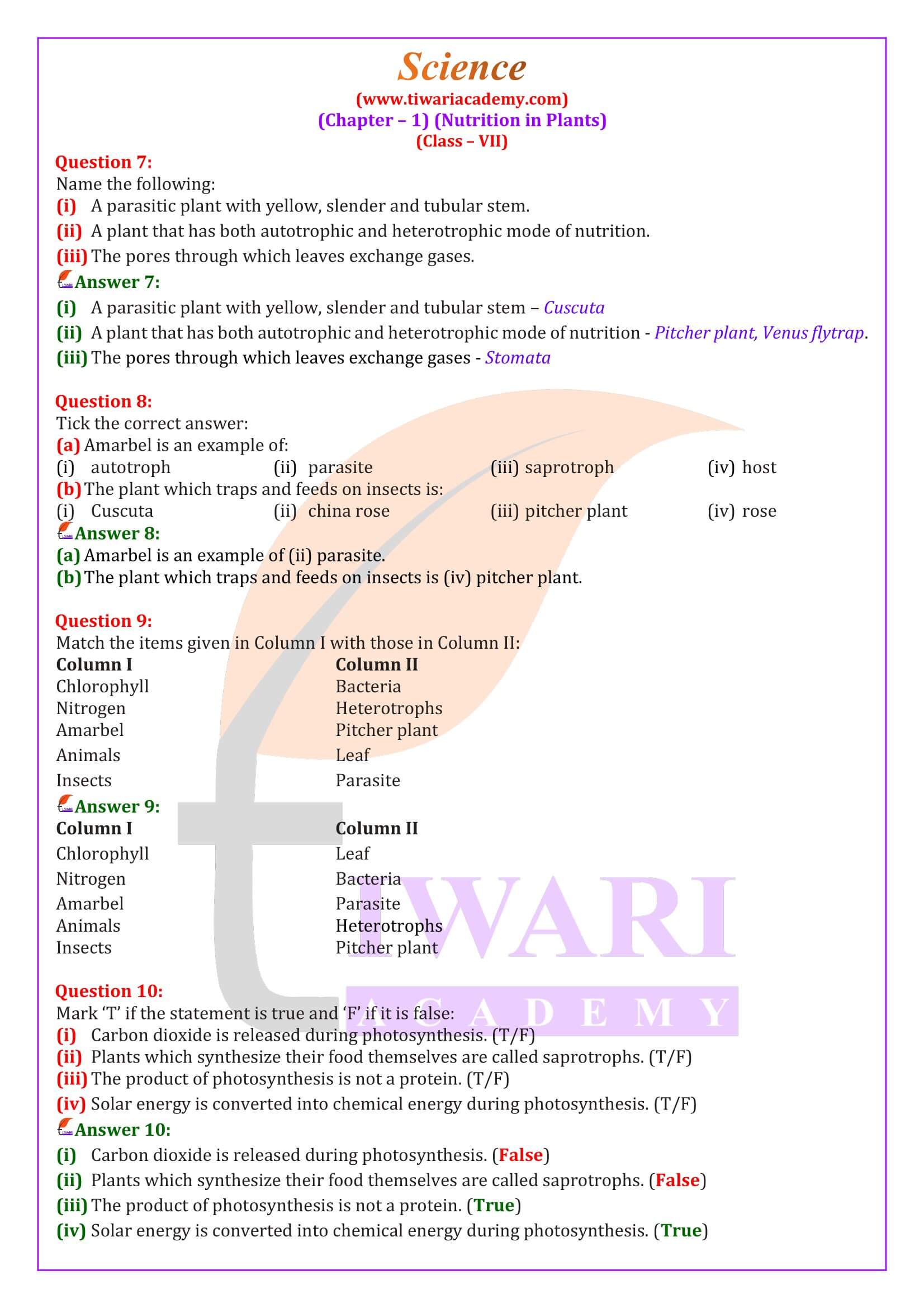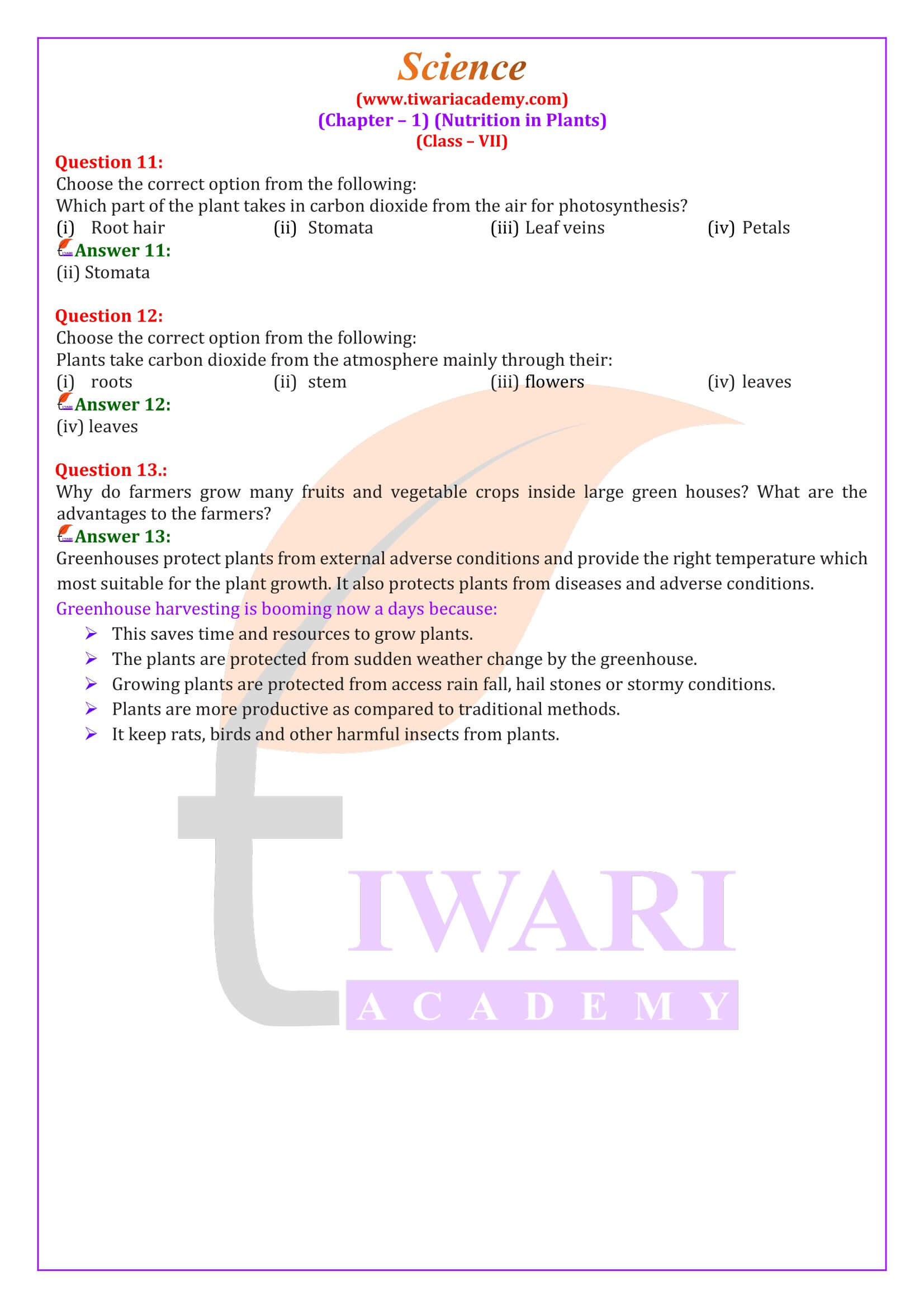Question Wise Class 7 Science Chapter 1 Solutions
Class 7 Science Chapter 1 NCERT Answers
Class 7 Science Chapter 1 in Hindi Medium
Class 7 Science Chapter 1 Extra Questions
Class 7 Science Chapter 1 MCQ Answers
Class 7 Science NCERT Book Download
NCERT Solutions for Class 7 Science
Class 7 all Subjects NCERT Solutions
NCERT Solutions for Class 7 Science Chapter 1 Nutrition in Plants in English Medium and Hindi Medium updated for Session 2024-25. The Hindi Medium solutions of Chapter 1 is also given here with Video. The question answers of chapter 1 class 7th Science are revised and modified as per new NCERT textbook issued for academic year 2024-25 exams.
| Class: 7 | Science |
| Chapter 1: | Nutrition in Plants |
| Content: | NCERT Exercises and Extra Questions |
| Session: | CBSE 2024-25 |
| Medium: | English and Hindi Medium |
Class 7 Science Chapter 1 in English and Hindi Medium
The descriptions of each important keywords, topics, intext questions and answers are also given for practice. Here, you can practice with the Multiple Choice Questions with answers and explanation. Important Questions related to 7th Science Chapter 1 and their answers are given for practice of terminal exams and school tests. You can download Chapter 1 solutions in PDF format updated for new academic session 2024-25. Videos explanation of complete chapter 1 of Class 7 science is given in Hindi Medium and English Medium to revise the entire chapter in one hour. NCERT Solutions 2024-25 are based on latest NCERT Books. Have any doubt? Visit to Discussion Forum and ask it.
Class 7 Science Chapter 1 Answers
Class 7 Science Chapter 1 Explanation in Videos
Important Main Point in Class 7 Science Chapter 1
1. Mode of Nutrition in Plants
In this part of the content gives you a fundamental idea about modes of nutrition which is usually required by different organisms. As we know, food is essential for all living organisms. The food contains some nutrients like, Carbohydrate, Proteins, Fats, Vitamins and Minerals which are required by our body for the growth and development, called nutrition. We get food from plants and animals, as you know. But how do plants get their food? Remember, plants can make their food themselves, but humans and animals cannot. Autotrophs are the mode of nutrition in which organisms make their own food. That means plants are autotrophs. Here, we cannot make our food; we are dependent on plants for the readymade form of food. So, we are known as ‘Heterotrophs’. Therefore, it is clear that the plant uses the autotrophic mode of nutrition for their growth and development. Nutrition in Animals and most of the other organisms is heterotrophic mode of nutrition for growth and development.
2. Photosynthesis – Food Making Process in Plants
In this part of the content focuses on the process of photosynthesis which is essential for the survival of all living organisms. Plants are the only organisms that can prepare food by using sunlight, water, carbon dioxide and minerals. You are surprised to know that leaves are the food factories of plants. Therefore, all the raw materials must reach there. The leaves have a green pigment called chlorophyll which captures the energy of the sunlight. This light energy is used to prepare food. So, this process is known as ‘Photosynthesis’. The raw material, i.e. carbon dioxide taken from the air through the tiny pores of leaves, called stomata. Water and minerals present in the soil are absorbed by the roots and transported to the leaves. The food produced by the process of photosynthesis is mainly carbohydrate which later gets converted into starch. During the process of photosynthesis, oxygen is released in the atmosphere. Thus, you can see how photosynthesis is essential for the survival of all living organisms.
3. Other Modes of Nutrition in Plants
There are some plants which do not contain chlorophyll in them and thus cannot prepare their food. They depend on other plants or organisms for food. Therefore, they are known as a parasite. You will be surprised to know that there are some plants which can trap insects and digest them. Such insect-eating plants are called insectivorous plants.
4. Saprotrophs
This part of the content introduces some other modes of nutrition which is usually essential for different organisms. You might have seen cotton-like threads spread on the rotten or wet piece of bread. These organisms are often known as fungi. The way they take their nutrients from dead or decaying matter called ‘Saprotrophs’. Remember, the mode of nutrition in which organisms take their nutrients from decaying matter called saprotrophic nutrition. Sometimes, two plants of different species live together and help each other in obtaining food and shelter. This association is called symbiosis, and such plants are called symbiotic plants. The association is significant for both of their survival.
5. How Nutrients Replenished in the Soil
You learnt that plants absorb nutrients from the soil. Crops require much nitrogen to make protein. After the harvest, the soil becomes deficient in nitrogen. Plants cannot use the nitrogen gas available in the atmosphere directly. The action of rhizobium bacteria can convert this nitrogen into a soluble form but that bacteria cannot make its own food. In return, leguminous plants provide food and shelter to the rhizobium bacteria. Thus, they have a symbiotic relationship as you learn before. This association is significant for the farmer, as they do not need to add nitrogen fertilizers to the soil in which leguminous plants are grown. In this way, you can see that every living organization needs some energy and nutrient materials to ensure that the life-processes go on smoothly.
Important Questions in Class 6 Science Chapter 1
1. The term that is used for the mode of nutrition in yeast, mushroom and bread-mould is
(a) autotrophic
(b) insectivorous
(c) saprophytic
(d) parasitic
2. Organisms which prepare food for themselves using simple naturally available raw materials are referred to as
(a) heterotrophs
(b) autotrophs
(c) parasites
(d) saprophytes
3. When we observe the lower surface of a leaf through a magnifying lens we see numerous small openings. Which of the following is the term given to such openings?
(a) Stomata
(b) Lamina
(c) Midrib
(d) Veins
4. In the absence of which of the following will photosynthesis not occur in leaves?
(a) Guard cells
(b) Chlorophyll
(c) Vacuole
(d) Space between cells
5. Two organisms are good friends and live together. One provides shelter, water, and nutrients while the other prepares and provides food. Such an association of organisms is termed as
(a) saprophyte
(b) parasite
(c) autotroph
(d) symbiosis
6. Which of the following statements is/are correct?
(i) All green plants can prepare their own food.
(ii) Most animals are autotrophs.
(iii) Carbon dioxide is not required for photosynthesis.
(iv) Oxygen is liberated during photosynthesis.
Choose the correct answer from the options below:
(a) (i) and (iv) (b) (ii) only (c) (ii) and (iii) (d) (i) and (ii)
7. Which of the following raw material is available in the air for photosynthesis?
(a) Oxygen
(b) Carbon dioxide
(c) Nitrogen
(d) Hydrogen
8. Pitcher plant traps insects because it
(a) is a heterotroph.
(b) grows in soils which lack in nitrogen.
(c) does not have chlorophyll.
(d) has a digestive system like human beings.
9. A goat eats away all the leaves of a small plant (balsam). However, in a few days, new leaves could be seen sprouting in the plant again. How did the plant survive without leaves?
10. Nitrogen is an essential nutrient for plant growth. But farmers who cultivate pulse crops like green gram, bengal gram, black gram, etc. do not apply nitrogenous fertilizers during cultivation. Why?
Answers of Important Questions
1 (c)
2 (b)
3 (a)
4 (b)
5 (d)
6 (a)
7 (b)
8 (b)
9. The plant survived on the food stored in the stem and roots.
10. Roots of pulses (leguminous plants) have a symbiotic association with a bacterium called Rhizobium which fixes nitrogen. Hence, farmers need not use nitrogenous fertilizers.
Important NCERT Questions Class 7 Science Chapter 1
Distinguish between a parasite and a saprotroph.
Organisms derive nutrition from the body of other living organisms (host) are parasites whereas Plants which derive nutrition from dead and decaying organisms are called saprotrophs.
How would you test the presence of starch in leaves?
Take a potted plant with variegated leaves – for example, money plant or crotons. Keep the plant in a dark room for three days so that all the starch gets used up. Now select a leaf cover its portion with a black strip paper and keep the plant in sunlight for about six hours. Pluck the leaf from the plant. Mark the uncovered area in it and trace them on a sheet of paper. Dip the leaf in boiling water for a few minutes. After this, immerse it in a beaker containing alcohol. Carefully place the above beaker in a water-bath and heat till the alcohol begins to boil. Now dip the leaf in a dilute solution of iodine for a few minutes. Take out the leaf and rinse off the iodine solution. You observe that the presence of starch in various areas of the leaf which was uncovered.
Fill in the blank: In photosynthesis solar energy is captured by the pigment called ___________.
In photosynthesis solar energy is captured by the pigment called Chlorophyll.
Fill in the blanks: During photosynthesis plants take in ___________ and release __________.
During photosynthesis plants take in carbon dioxide and release oxygen.
Name the following: A parasitic plant with yellow, slender and tubular stem.
A parasitic plant with yellow, slender and tubular stem – Cuscuta








